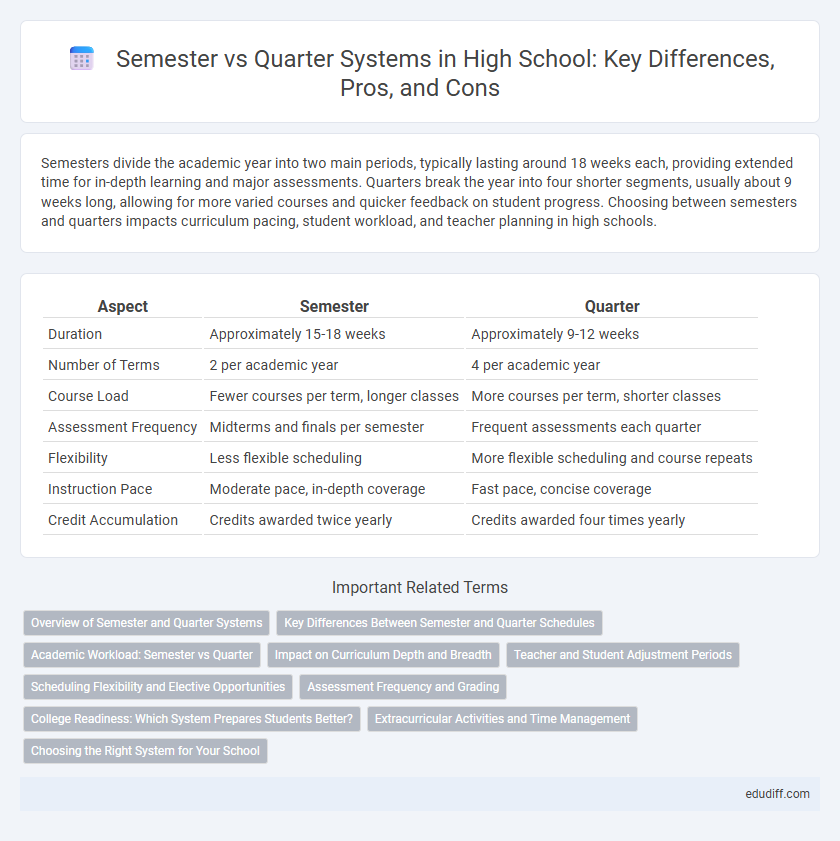Semesters divide the academic year into two main periods, typically lasting around 18 weeks each, providing extended time for in-depth learning and major assessments. Quarters break the year into four shorter segments, usually about 9 weeks long, allowing for more varied courses and quicker feedback on student progress. Choosing between semesters and quarters impacts curriculum pacing, student workload, and teacher planning in high schools.
Table of Comparison
| Aspect | Semester | Quarter |
|---|---|---|
| Duration | Approximately 15-18 weeks | Approximately 9-12 weeks |
| Number of Terms | 2 per academic year | 4 per academic year |
| Course Load | Fewer courses per term, longer classes | More courses per term, shorter classes |
| Assessment Frequency | Midterms and finals per semester | Frequent assessments each quarter |
| Flexibility | Less flexible scheduling | More flexible scheduling and course repeats |
| Instruction Pace | Moderate pace, in-depth coverage | Fast pace, concise coverage |
| Credit Accumulation | Credits awarded twice yearly | Credits awarded four times yearly |
Overview of Semester and Quarter Systems
The semester system divides the academic year into two main periods, typically lasting 15 to 18 weeks each, allowing for in-depth study and comprehensive assessments. The quarter system splits the year into four shorter terms, usually around 10 to 12 weeks, enabling faster course rotations and flexibility in scheduling. Both systems influence curriculum pacing, student workload, and credit distribution in high school education.
Key Differences Between Semester and Quarter Schedules
Semester schedules typically divide the academic year into two main periods of approximately 18 weeks each, allowing students to focus deeply on fewer subjects per term. Quarter schedules split the year into four periods lasting about 9 to 10 weeks each, offering a faster-paced curriculum with more frequent course changes. Key differences include course load intensity, pacing of content delivery, and flexibility in credit accrual, impacting academic planning and student workload management.
Academic Workload: Semester vs Quarter
High school academic workload varies between semester and quarter systems, with semesters typically encompassing two 18-week terms allowing for deeper exploration of subjects but longer assignments. Quarter systems divide the year into four 9-week terms, often resulting in a faster pace and more frequent assessments, which can increase short-term workload intensity. Students in semester systems may experience concentrated workload periods, while quarter systems require consistent time management due to rapid course turnover.
Impact on Curriculum Depth and Breadth
Semester systems allow for deeper exploration of subjects by providing longer class periods and extended time frames, which supports comprehensive understanding and skill development. Quarter systems increase curriculum breadth by enabling students to take more courses in diverse areas within an academic year. Schools using semesters often emphasize mastery and in-depth projects, while quarter-based schedules prioritize exposure to a wider variety of disciplines.
Teacher and Student Adjustment Periods
Semester schedules allow teachers and students a longer adjustment period with extended time for instruction, assessment, and mastery of material. Quarter systems require faster pacing, demanding quicker adaptation to new subjects and grading cycles, which can increase pressure on both educators and learners. Understanding these timelines helps optimize teaching strategies and study habits to improve academic performance and reduce stress.
Scheduling Flexibility and Elective Opportunities
Semester systems, typically lasting 15 to 18 weeks, offer extended time for in-depth study and project completion, allowing students to delve deeply into core subjects. Quarter systems, divided into four shorter terms around 9 weeks each, provide greater scheduling flexibility by enabling students to enroll in more courses annually and explore diverse electives. High schools using quarter schedules increase elective opportunities, giving students the ability to tailor their education with specialized classes that might not fit into a semester-based timeline.
Assessment Frequency and Grading
Semester systems divide the academic year into two halves, resulting in fewer assessments but longer periods for grading. Quarter systems split the year into four terms, allowing for more frequent assessments and quicker feedback on student performance. This increased assessment frequency in quarters can improve grade accuracy and timely intervention for student progress.
College Readiness: Which System Prepares Students Better?
Semester systems offer in-depth learning with extended class periods that foster critical thinking and long-term retention, aligning well with college course structures. Quarter systems provide accelerated pacing and frequent assessments that build adaptability and time management skills essential for college success. Evidence suggests that semesters better prepare students for rigorous college workloads by emphasizing comprehensive understanding over shorter-term memorization.
Extracurricular Activities and Time Management
Semesters typically span 15 to 18 weeks, allowing high school students more time to engage deeply in extracurricular activities such as sports, clubs, and arts programs. Quarters, lasting about 9 weeks, require students to manage their time efficiently to balance academics with extracurricular commitments within shorter periods. Effective time management skills are crucial in both systems to maintain academic performance while actively participating in extracurricular opportunities.
Choosing the Right System for Your School
Selecting between semester and quarter systems depends on your school's academic goals and scheduling needs. Semester systems provide longer periods for in-depth learning, typically dividing the academic year into two main segments, whereas quarter systems split the year into four shorter terms, allowing for more course variety and flexibility. Considering factors like curriculum pacing, student workload, and credit requirements helps determine the most effective structure for maximizing student engagement and academic achievement.
Semester vs Quarter Infographic

 edudiff.com
edudiff.com